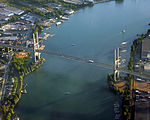Annacis Island

Annacis Island is a narrow island under the jurisdiction of City of Delta in Lower Mainland, British Columbia, located just downstream of the south arm of the Fraser River bifurcation between Lulu Island to the north and the Delta peninsula to the south. The island is now mostly an industrial zone, and contains one of Metro Vancouver's secondary wastewater treatment plants, the Annacis Island Wastewater Treatment Plant. The island is also home to the British Columbia Institute of Technology's Annacis Island campus.The southern part of the island is connected to Delta via the Alex Fraser Bridge, which is part of Highway 91. Connections northward to Richmond and New Westminster are via smaller bridges on Highway 91. At the eastern end of the island there is also the Annacis Island Swing Bridge which connects the island to the Queensborough neighborhood of New Westminster on the eastern end of Lulu Island. Annacis Island is served by a public bus that connects to 22nd Street Station in New Westminster. The wider part of the Fraser River south of the island is known as Annieville Channel (upstream) and City Reach (downstream), while the more narrow channel north of the island is Annacis Channel. The eastern (upstream) tip of the island is known as Shoal Point, and the western (downstream) tip as Purfleet Point.
Excerpt from the Wikipedia article Annacis Island (License: CC BY-SA 3.0, Authors, Images).Annacis Island
Derwent Way, Delta
Geographical coordinates (GPS) Address Website Nearby Places Show on map
Geographical coordinates (GPS)
| Latitude | Longitude |
|---|---|
| N 49.166666666667 ° | E -122.94972222222 ° |
Address
Annacis Island Wastewater Treatment Plant
Derwent Way 1299
V3M 5V9 Delta
British Columbia, Canada
Open on Google Maps




